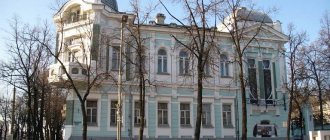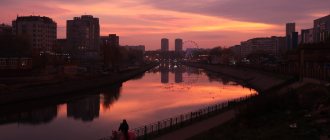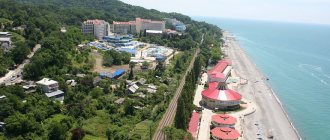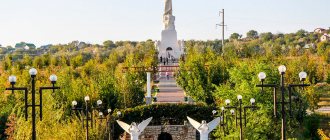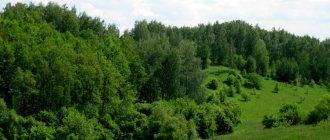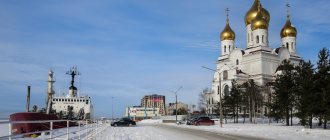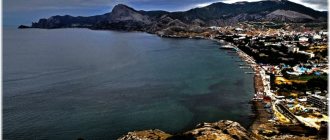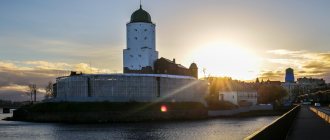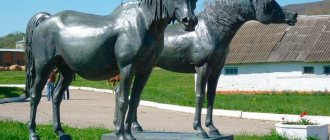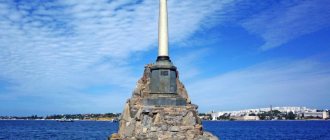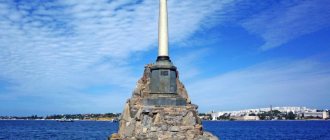Sergiev Posad stands out among the main attractions of the Moscow region, and indeed the whole country. This is much more than a beautiful old policy - one of the stars on the tourist map of the Russian Federation. Here a special form of spirituality arose, based on sincere faith in God, strict adherence to the commandments of the Lord, readiness for self-sacrifice for the good of the Fatherland, which has now become a generally recognized identifier of the Russian people. The forerunner of the modern city was the settlement formed around the monastery monastery founded by Sergius of Radonezh. Under Ivan the Terrible, the monastery, surrounded by brick walls with powerful towers, turned into an impregnable citadel. The fortress withstood a 16-month Polish siege during the Time of Troubles, and 79 years later it became a reliable shelter for the young prince from the Romanov dynasty, the future first Russian emperor. Subsequently, Sergiev Posad, which received city status in 1782, was repeatedly visited by august persons. Great thinkers of the past, famous writers came here - from the classics of Russian literature L. Tolstoy, M. Lermontov, N. Gogol, to A. Dumas the Father and L. Carroll. During the Soviet era, the polis, which bore the name Zagorsk from 1930 to 1991, became a significant part of the industrial cluster near Moscow. However, for hundreds of thousands of travelers it continues to be, first and foremost, a tourist Mecca.
Trinity-Sergius Lavra
Address : between Ilyinskaya Street and Red Army Avenue.
One of the centers of Russian Orthodoxy, a place of pilgrimage for thousands of people every year. The Lavra in Sergiev Posad attracts crowds of pilgrims as a place of special power, as a place associated with the beloved Russian saint - St. Sergius of Radonezh. The Lavra appeared thanks to the Monk Sergius and his brother Stephen. The monastery played a significant role in the politics of the Russian state long before it became a monastery. Temples were erected and decorated by the best craftsmen, contributions (church utensils, icons) were made by kings and scions of ancient princely families.
The main shrine of the Lavra - the relics of St. Sergius - are kept in the reliquary of the Holy Trinity Church. Also in the Holy Trinity Cathedral you can see icons of Simon Ushakov. In the 17th century, when the Russian Orthodox Church was going through difficult changes, Simon Ushakov created icons that combined the best features of Russian, Byzantine and even secular art.
The Lavra is open to visitors from 8.00 to 21.00. Near the Lavra there are 3 hotels for pilgrims. It is best to book a room a week or a week and a half in advance if you are going to travel during an Orthodox holiday. You can find out about confession and communion on the Lavra website. The Trinity House of Crafts operates at the Lavra, where you can get acquainted with different types of manual labor and learn about caring for flowers.
The main attractions of Sergiev Posad: TOP-5
The most recognizable historical or architectural monuments are considered to be the tourist symbols of any city. This category includes the sights of Sergiev Posad, photos and descriptions of which are presented below.
Trinity-Sergius Lavra
- Address: Sergiev Posad. Transport stop "Center" White Pond.
The Trinity-Sergius Monastery dates its history back to 1337. Then Sergius and Stefan of Radonezh settled on Makovetsky Hill. Soon the brothers erected the first temple on the territory of the current monastery - the Trinity Church. The great saint of the Russian land, abandoned by Stephen, spent several years alone, and then other monks began to settle not far from his cell. This is how the famous monastery arose. The monastery was destined to play a huge role in the history of Russia. Here Sergius of Radonezh blessed the army of Dmitry Donskoy before the Battle of Kulikovo, sending the warrior-monks Peresvet and Oslyabya with the army. The princes of Moscow baptized their children in the Trinity Cathedral. During the Time of Troubles, the monastery remained the main spiritual stronghold of Russian statehood. Even the Bolshevik atheists did not raise their hands to this shrine. The Lavra was not destroyed, but turned into a museum. Today, the unique architectural and historical ensemble, declared a World Cultural Heritage Site by UNESCO, is maintained in excellent condition. The monastery complex consists of 11 ancient churches and more than 40 historical buildings for various purposes.
Trinity Cathedral
- Opening hours: daily from 6:00 to 19:00.
- Telephone.
- Website: https://www.stsl.ru/about_lavra/all/troitskiy-sobor
- Address: Trinity-Sergius Lavra.
The temple, consecrated in 1423, is considered the heart of the Trinity-Sergius Lavra. It was around the white stone building, erected under Abbot Nikon of Radonezh, who was canonized 124 years later, that the architectural ensemble of the monastery was formed. The significance for believers of the cathedral, decorated outwardly in a discreet manner in the old Russian style, is difficult to overestimate. Under its shade, in a silver shrine, one of the main shrines of Orthodox Russia is kept - the relics of St. Sergius of Radonezh, miraculously found during the construction of the church. The continuous iconostasis of the temple was created by Daniil Cherny and Andrei Rublev. These great masters also painted the walls of the cathedral, but the ancient frescoes have not survived to this day. In the second third of the 17th century. the ancient drawings were carefully reproduced by the icon painters of the monastery.
Towers of the Trinity-Sergius Lavra
- Address: Trinity-Sergius Lavra.
Until the middle of the 16th century. The only stone building of the Lavra was the Trinity Cathedral. Everything changed during the reign of Ivan the Terrible. The autocrat not only ordered the reconstruction of the monastery, but also turned it into a powerful fortress. The monastery was surrounded by a high white stone wall with 11 towers, which have survived to this day. Below we will talk about the most colorful fortifications of Sergiev Posad.
The construction of six tiers of the Pyatnitskaya Tower was completed in the late 40s of the 17th century. A century later, it was decorated with a baroque dome topped with a rotunda-lantern. According to legend, during the time of Ivan the Terrible, adversaries were executed in the interior of the building.
The corner Duck Tower is considered the most beautiful in the architectural ensemble of the citadel. The walls of the 22-meter stone octagon are covered with intricate patterns, original ornaments, and openwork decor. The roof is crowned with a high spire, on which is placed a duck carved from stone. It is believed that the building owes its name to Peter I, who loved to shoot game from the upper tier.
The Kalichya Tower dates back to the second half of the 18th century. Externally, the building bears little resemblance to a fortification. Rusticated masonry, pseudo-porticos, and carved decor give the tower a solemn and festive appearance.
Bell tower of the Lavra
- Address: Trinity-Sergius Lavra.
The drums and shining domes of the Lavra's temples are dominated by a crowned gilded dome, crowning the white and turquoise pillar of the main bell tower of the Lavra. The height of the five-tier structure is 88 meters. At the same time, the building does not look massive at all. It seems to float above the complex of surrounding buildings. Having survived a period of relative oblivion during the Soviet era, the bell tower, after restoration completed in 2014, appears before tourists in all its splendor. The 42 bells of its belfry once again delight believers with their unearthly sound during Christian holidays. The largest of them is “Tsar”, weighing 72 tons. The tower's chimes still methodically count down the minutes, announcing the arrival of a new hour with the sound of bells.
Complex of shopping arcades
- Address: Red Army Avenue, 131. Transport stop "Trading Rows".
The most notable secular building in Sergiev Posad is the Trading Rows. The red brick buildings, erected at the very beginning of the last century, are located directly opposite the Lavra, fitting perfectly into the historical architectural ensemble of Krasnogorskaya Square. A large fire that engulfed the building in the summer of 1920 destroyed the magnificent tent that covered the main portal and the elegant turrets that adorned the façade. Fortunately, for the celebrations of the 700th anniversary of the great saint in 2014, the shopping arcades were completely restored and regained their original appearance.
"Bells of Rus'"
Address : Grigorovo village, Vladimir region; 25 km from Sergiev Posad along the A108 highway.
The exhibition of bells consists of several expositions. The history of the bell as a musical instrument is told here step by step and in detail. The first section is devoted to the beat, the second - to the bells. Bells of different shapes, wooden, stone, tin, were collected. Flat bells are also exhibited here. During the excursion you can feel the effect of sound waves using the bilotherapy method. Bilotherapy was officially recognized no more than 10 years ago. At the exhibition “Bells of Rus'” you can feel the physical effect of singing bronze and tin. Bilotherapy sessions take place in one of the premises of the Bells of Rus' exhibition; advance registration is required.
At the concert of the Bells of Rus' ensemble you can hear the performance of famous military and folk songs, romances based on poems by Silver Age poets, and waltzes. The ensemble also plays songs from Soviet films, musicals, and songs from the repertoire of Evgeny Martynov, Vladimir Vysotsky, and Joe Dassin on bells.
Pre-registration is required to visit the exhibition. The cost of a two-hour concert is up to 2000 rubles. Tea drinking is organized for groups of up to 5 people. Master classes on playing bells have been organized; 10 minutes of play will cost 100 rubles.
Working hours : from 9.00 to 21.00, seven days a week.
Church-archaeological office
Address : Holy Trinity Sergius Lavra.
The collection of icons and coins existed back in the 19th century. The church museum was opened in 1880. The exposition of the Church Archaeological Museum numbers more than 20 thousand items. There are Russian and Byzantine icons, handwritten and early printed books, graphics and religious relics. The relics will tell a lot about the history and priests of the Russian Orthodox Church.
In the church museum there are antique items made using wood and bone carving techniques, micromosaics, and embroidered fabrics. It is here that the first printed “Apostle” by Ivan Fedorov from 1564 is kept, as well as the Ostrog Bible from 1581.
Photography and video shooting are prohibited in the museum; mobile phones must be turned off at the entrance. Professional photography and video shooting is possible with the permission of the administration. Smoking is prohibited on the territory of the museum and theological seminary. The cost of visiting the church museum is from 20 to 100 rubles.
Opening hours : Mon-Sat – from 9.00 to 18.00, Sun – from 11.00 to 18.00. Tours are not available during the first and last weeks of Lent.
FAQ
What attractions are there near Sergiev Posad? Ethnopark “Nomad”, Gremyachiy Klyuch Waterfall, Muranovo Estate named after F.I. Tyutchev, Abramtsevo Museum-Reserve, Spaso-Vifansky Monastery, Chernigov Skete.
What sights of Sergiev Posad can you see on your own? Krasnogorskaya Square, Pancake Mountain observation deck, Holy Trinity Sergius Lavra, Elias Church.
Where can you go with children in Sergiev Posad? Ethnopark “Nomad”, “Park of Wonders”, Museum of Impressions, Museum of Toys, Museum Complex “Horse Yard”.
Sacristy
Address : Holy Trinity Lavra.
All valuables and rare things of the Holy Trinity Lavra are kept in the sacristy museum. A sacristy is a room in an Orthodox church where clergy vestments and church utensils are stored. The sacristy-museum preserves handwritten books and royal gifts. In the sacristy you can also see gifts from relatives of the deceased. After the death of Prince Fyodor Mstislavsky, his relatives brought a pearl-gold miter to the Lavra as a gift. Mstislavsky participated in the election of Mikhail Romanov, but lost all his children during the Time of Troubles. After his death, all his possessions were transferred to the Trinity-Sergius Monastery.
If under Ivan the Terrible the Lavra became the main landowner in Rus' and acquired the Assumption Cathedral, then under Boris Godunov it received valuable gifts of high art. Educated and familiar with European art, Boris Godunov made contributions of exquisite church utensils. Having become king in 1598, he donated a chalice and plates made using the technique of niello on gold to the Trinity-Sergius Lavra. The sacristy houses another gift from Boris Godunov - the setting of the Holy Trinity icon by Andrei Rublev.
The sacristy museum stores not only gifts from the monastery’s benefactors, but also records about it. A 17th-century loose-leaf book contains records of gifts from the very foundation of the monastery. Using the Contribution Book you can study the history of the Moscow State. This document is evidence of the significant influence of the church on domestic politics in the 14th-17th centuries.
The cost of visiting is from 200 to 500 rubles. Working hours: from 9.30 to 18.00, days off - Monday, Tuesday.
Matryoshka Museum
Address : 1st Shock Army Street, 2.
The Trinity-Sergius Lavra has always been the richest monastery in Russia. The patrimonial estates needed to be maintained; the fields and farms needed a large number of horses. More than 700 horses were kept at the monastery. After the confiscation of monastery lands under Catherine II, the equestrian yard was reduced and rebuilt.
Now it is a very beautiful building, built in the shape of a square, with round turrets, planked roofs, and bronze horsemen prancing on the spiers of the turrets. Nowadays, the buildings of the monastery equestrian yard house exhibitions of the historical and art museum, telling about the development of Russian folk art. Also here is the “Matryoshka Museum” with the richest collection of toys in Russia. The best toys from Nizhny Novgorod, Polkhov, Vyatka and Podolsk workshops are collected in Sergiev Posad. The keeper of the museum is a matryoshka doll that has passed the hundredth year. Among the nesting dolls you can see a variety of characters - peasants, queens, astronauts, saints.
The cost of visiting the matryoshka museum is up to 200 rubles. Tours are conducted in Russian, English and German.
Working hours : from 10.00 to 17.00, days off - Monday, Tuesday.
Pavel Florensky Cultural Center
The Pavel Florensky Cultural Center was created on the initiative of the foundation of the same name, which popularizes science and Orthodox culture. The institution includes the main building with an annex on Vifanskaya Street and the adjacent territory of the estate with all its premises.
Pavel Florensky Cultural Center
The Pavel Florensky Foundation is a young organization - it was founded in 2011. Since 2012, work has been underway to equip the Cultural Center in Sergiev Posad. In 2016, the foundation organized a Christmas art festival in the city, and in 2017, the first exhibition entitled “Face and Face” was opened. The exhibition consists of photographs and portraits of Pavel Florensky.
The collection of the Cultural Center is gradually replenished with materials related to the life, work and work of the outstanding priest and religious philosopher. It is planned to open departments that will be dedicated to numismatics, scientific inventions, music, etc.
- Address: Vifanskaya street, 2.
- Information: by phone 8(905)-767-89-13.
Toy Museum
Address : Red Army Avenue, 123.
The museum was founded in 1918 by philanthropist and collector Nikolai Dmitrievich Bartram in Moscow. From early childhood he made toys in his father's art workshop. Fascinated by history and ethnography, Nikolai Bartram traveled around the provinces and collected folk costumes to reproduce them in miniature. The master also came up with the idea of putting Russian national costumes on the porcelain dolls. Nikolai Bartram is also known for creating an architectural toy - a prototype of models. After the revolution and the nationalization of private apartments, the toy museum did not close, it was even replenished with new toys from the landowners' estates. In 1931 the museum was moved to Sergiev Posad.
The cost of visiting is up to 300 rubles, children under 5 years old are free. Free admission for large families and children under 18 years of age – every Thursday. Free photo and video shooting. Master classes are held by appointment. You can make paper or rag dolls. The masters will also teach you how to paint nesting dolls and help you make your first toy from clay or wood.
Opening hours: from 10.00 to 17.00; Weekends – Monday, Tuesday.
Infrastructure
The sights of Sergiev Posad, due to its short distance from Moscow, attract not only domestic but also foreign tourists: it is quite possible to see everything you want in one day and return to the capital, saving on hotel costs.
The most convenient ways to get to Sergiev Posad from the capital:
- Electric train - departs from Yaroslavsky station, the cost of a one-way ticket is 164 rubles, the journey takes about one and a half hours.
- Bus – departs from the VDNKh metro station every 20-30 minutes; the journey will take from one and a half to two hours, depending on the number and duration of stops.
- Private car - you can also hire a taxi from the VDNKh metro station, if you get there with fellow travelers, it will be cheaper. Or go on a trip in your car along the Yaroslavl highway (no more than 70 km to the destination).
When planning a trip, you should think not only about how to get to Sergiev Posad, but also where to stay if you have to spend the night. Even the simplest hotels of average comfort level are quite expensive here, which is quite natural, given the proximity of the capital and the fantastic popularity among tourists, it is advisable to reserve rooms and apartments in advance.
Final advice: in all Orthodox monasteries, without exception, the food is delicious. Usually homemade pastries, pickles and jam can be bought in the shops at the monastery - experienced tourists say that you won’t regret it. Even in the city, in almost every grocery store and stall you can find Sergiev Canon products - Lavra fruit drink of various varieties, tea, gingerbread. These will be the best gifts and souvenirs from the trip, not counting nesting dolls, magnets and down scarves.
Bogorodsk Toy Museum
Address : Slobodka street, 79B, Bogorodskoye village. 25 km from Sergiev Posad.
The wooden Bogorodsk toy was first mentioned in the 15th century. The peasants assigned to the Trinity-Sergius Lavra were skilled woodworkers. The village of Bogoroditskoye was one of the centers of folk applied art in Rus'. The secrets of craftsmanship were passed on from father to son; this tradition was not interrupted by the Time of Troubles. At the beginning of the 20th century, the Bogorodsky Carver artel was known throughout Russia; artel masters opened a vocational school. Bogorodsk toys can be seen in museums in Moscow and St. Petersburg. The Bogorodsk Toy Factory successfully participates in Russian and international exhibitions.
In this toy museum you can learn physical laws, because among the exhibits there are many moving toys that perform simple actions. Children will love the wooden decorated chickens that peck at grain or the man and the bear that take turns beating an anvil. In addition to children's toys, in the museum you can see high reliefs and cabinet sculptures, miniature tabletops and floor monuments.
Masters of the factory where the museum is located conduct master classes:
- assembly of carved and turning toys;
- carving of wooden sculpture;
- painting of a turning toy.
Master class prices range from 400 to 3000 rubles. The cost of visiting an hour and a half excursion is up to 150 rubles.
Working hours : from 10.00 to 16.00, seven days a week.
Infrastructure
Where to stay?
The choice of accommodation for the night directly depends on the purposes for which the tourist came. If this trip is of a pilgrimage nature, then it is worth considering accommodation options on the territory of the Lavra or in the hotel of the Temple of the Archangel Michael. You should not expect such rooms to be equipped according to European standards. People come here not for comfort, but for spiritual help, and the last thing they are interested in is the luxury of a room.
So, if you want to stay at a hotel at the Lavra, you need to find a pilgrimage information center. There you need to present your passport, sign papers and pay a certain amount.
If we talk about other options, it could be the Old Lavra Hotel or the Voznesenskaya Hotel. Also, they are located near the shrine and offer comfortable living conditions in an economy format. The price for such an overnight stay ranges from 300 to 500 rubles.
For a more relaxed holiday, the following hotels open their doors: Hotel “, Hotel “Posadsky”, Hotel “Aristocrat”, “Russian Yard” and others. The hotels offer accommodation in fully equipped rooms, with the ability to order food in the restaurant. There is Internet access and parking. Price per night from 2500 rubles.
In the private sector, there are also many rooms for rent. For an economical holiday, you can even rent just a bed next to other pilgrims - from 200 rubles per night.
Mobile operators - Rostelecom, Beeline, Tele2 operate throughout the city - there should be no problems with communication.
You don’t have to worry about your safety in this region, because the majority of people are friendly locals or believers who have come to venerate the holy relics.
Shopping
Considering the size of the city and the number of residents, investors are in no hurry to pour money into the development of the retail and entertainment sectors. Therefore, if you want to go to large shopping centers and hypermarkets, it is better to go to Moscow.
The following small trading platforms operate in Sergiev Posad: Capitol and Schastlivaya 7ya. Here tourists and local residents can buy clothes, shoes, hygiene products and necessary child care items.
What to bring from your trip?
Since this direction is more focused on pilgrims, the main thing that people buy as souvenirs are icons and holy attributes. Each visitor believes that the thing brought from this region has special power and protects. On the territory of the Lavra there are both icon shops and souvenir shops where you can buy your favorite souvenirs.
Also, folk craft items are especially popular - lace fabrics, wooden dishes and painted matryoshka dolls, figured sweets and gingerbread cookies, paintings from folk artists and more. The choice is so great that visiting tourists are simply lost.
Kitchen and food
For people from the CIS, the cuisine of the local region will not be exquisite - pancakes, cabbage soup, pastries, rich porridges, homemade meat prepared according to folk recipes. Favorite drinks are vodka and kvass.
If we talk about restaurants and cafes, they are inexpensive here. For example, the “Pirosmani” cafe, everyone’s favorite vareniki, pie “OGOGO” and “Guest Hut” will pleasantly surprise you with a cozy atmosphere and reasonable prices. Restaurant "Grilyazh" for lovers of haute cuisine and delicacies.
Where to go in the evening? Tourists who come to visit not only holy places can go out in the evening to the Sinatra karaoke bar or visit the Zvezdochka nightclub.
Temple of Elijah the Prophet
Address : Ilyinskaya street, 5/1.
Elias Church was built in the 14th century, but the events of the Time of Troubles had a devastating impact on the church. The pink and gilded wooden church has survived several fires. In the 18th century, at the request of Sloboda residents, the church was rebuilt in stone. The bricks for the temple were made at the drying oil plant in Sergiev Posad. The dark red church with whitewashed portals and white platbands looked more elegant than other churches in the city. Inside the temple, a gilded 19th-century iconostasis, columns and cornices have been preserved. Father and son Malyshevs were engaged in painting the temple for half a century. Ivan Malyshev painted the Ilyinskaya Church for the first time, and his son updated the frescoes and introduced new images.
The Church also has its own martyr. After the October Revolution, the priest of the church, Nikolai Benevolensky, conducted services in secret for almost 20 years, but in 1939 the priest was arrested. Two years later, Nikolai Benevolensky died in the Karaganda camp. An example of how Father Nikolai was able to conduct church services, despite anti-religious propaganda, helped the parish of the Church of Elijah the Prophet survive during the war years. In the only open church in Sergiev Posad, services and prayers were held for those who went to war. The church holds daily morning liturgy and evening services.
Church of the Presentation of the Blessed Virgin Mary into the Temple
Church of the Presentation of the Blessed Virgin Mary
The temple was built in 1547. In subsequent periods it was rebuilt many times. The modern architectural face is still characteristic of churches with features of the 16th - 18th centuries. On such traditional cross-domed churches, one dome was built.
Under Soviet rule, the temple was closed (1928). It became empty and looked abandoned. In 1960, restoration of the former temple building began. Restoration work was carried out by the Zagorsk Museum-Reserve, under whose jurisdiction the church was transferred. The cathedral was finally returned to the faithful in 1991. Since then, restoration procedures for the interior of the church have continued. Particular importance is attached to the restoration of the iconostasis.
Today it is a stone, single-domed building with a two-tier structure. Refers to the cross-dome type. A single gilded top crowns the snow-white walls. A kind of crown with a brilliant tint is created above the church. The building attracts with its slenderness and majesty. Such properties are the result of a combination of architectural traditions from several centuries.
The church is located at: Red Army Ave., 127.
Gremyachiy key
Address : Vzglyadnevo village, 27 km from Sergiev Posad along the A 108 highway.
Legend says that this source appeared in the 14th century with the blessing of St. Sergius of Radonezh. All year round, the water in the source maintains a temperature of 6º. The water is considered healing, it contains a lot of radon. At the source there are indoor baths, stairs for descending into the water, and changing rooms are equipped. Church services are held on Sundays and Orthodox holidays in the Church of the Forty Martyrs of Sebaste and in the gate church. The service starts at 6.40. There is a refectory with hot food, open from 9.00 to 20.00.
When visiting a holy spring, it will be useful to remember some rules:
- wear a pectoral cross;
- swim in a long shirt;
- women can only enter the water on clean days;
- take a dip in separate baths for men and women;
- It is prohibited to drink alcoholic beverages and smoke;
- It is prohibited to throw coins and garbage into the water.
The access to the source is not paved; in rainy weather, only SUVs can drive along the dirt road. The source is available for diving at any time.
Source of St. Savva the Watchman
Monk Savva was a student of Sergei of Radonezh, who is the founder of the Lavra. From a young age he renounced everything worldly and lived in a monastery. He was known among people for his kindness and good deeds. As local legends say, he devoted a lot of time to prayer. Thanks to this, a spring appeared near the walls of the monastery, the water of which is considered holy. Near the source there is a bathhouse where you can take a bath at any time of the year. Pilgrims also collect holy water for drinking, as it is believed by many believers to have healing properties.
Source of St. Savva the Watchman
Desert of the Holy Paraclete
Address : Smena village, 6 km from the Trinity-Sergius Lavra.
The monastery was built in 1858 on the initiative of the benefactor of the merchant of the 2nd guild, Ivan Kirillovich Korolev. Monks of the Lavra came to the monastery and wanted to accept a stricter fast. While living in the monastery, they accepted the obligation of intense prayer. The monks lived as hermits in the desert; entry was prohibited for visitors.
The location for the Paraclete Desert was not chosen by chance. This place was chosen by one of the revered holy fools of the Lavra. 12 cells were built, spaced apart from each other. The hermits spent the entire day in solitude, gathering together only for meals and for common work. The monks made an exception for the ktitor (benefactor) of the monastery and accepted him into the monastery. In due course, the Paraclete Hermitage became the resting place of the merchant Korolev and his wife.
In the 1920s The hermitage was able to exist as a labor artel, but later the monastery was abolished. The Paraclete desert became operational again 30 years ago. Two desert temples retain pre-revolutionary floors and decorative trim. Evening services are held daily in the desert, and prayer services are held in the morning. Here, far from the grandiose Lavra, between a vegetable garden and a hayfield, you can find solace and reinforcement in solitary prayer. On Orthodox holidays you can hear sermons by Archimandrite Luke.
Prayers are held in the morning at 7.40, evening services are held daily from 17.00.
Chernigov monastery
Address : Gethsemane Ponds street, 1.
The Chernigov monastery was founded in 1847 by the holy fool Philip Khorev, a former Vladimir serf. Having retired from the Trinity-Sergius Lavra to the Isakov grove, Philip Khorev dug himself an underground cell and settled in it as a hermit. Five years later, in Isakovskaya Grove there were already several underground cells and a church in a log dugout.
The main icon of the monastery is the Chernigov Icon of the Mother of God. According to legend, in 1869 the icon healed a peasant woman who was paralyzed. The monastery was known throughout the Russian Empire thanks to Saint Barnabas, who began as a novice in the monastery and became the people's confessor. Ordinary people and high-ranking officials listened to him. Turn-of-the-century religious writers Vasily Rozanov and Konstantin Leontyev are buried in the skete cemetery.
On the territory of the skete there is a monastery refectory for pilgrims, open from 8.00 to 20.00. The monastery’s temple accepts services for memorials and health; you can also order services on the website.
Abramtsevo
Address : Museum street, 1, Abramtsevo village. 20 km from Sergiev Posad.
The estate of the famous Aksakov family was a haven for writers and artists. The guests of Sergei Timofeevich Aksakovo were famous Russian writers I. Turgenev, M. Zagoskin, S. Shvyrev, A. Fet. Shortly before his death, Gogol read the second volume of Dead Souls to the Abramtsevo circle. Abramtsevo also became the unofficial headquarters of Slavophiles who studied folk life and language.
Since 1870, the estate belonged to the philanthropist Savva Mamontov. A workshop for working with ceramics and wood was built especially for the guest artists. Under him, Abramtsevo became a home for populist artists. The circle of artists in Abramtsevo revived interest in folk art. The sculptures and panels created in Abramtsevo were noted for their ornamental forms and traditional vocabulary.
The manor house has stood since the 19th century, untouched by fires and political disasters. Now in the house you can visit exhibitions dedicated to famous guests. There is even a “Chronicle of the village of Abramtsevo”, which preserves the memory of the glorious days of the creative intelligentsia of the 19th century. The estate also houses a gallery of 20th century paintings. Among the documentary exhibits, it is worth paying attention to S. Aksakov’s drafts for a book about fishing and hunting. The writer was one of the first to create a manual on fishing and hunting.
Entrance to the park – 100 rubles. The museum allows paid photography and video shooting - 200 rubles.
Opening hours : from 10.00 to 18.00, on Saturday – from 10.00 to 20.00; Weekends – Monday, Tuesday.
Khotkovsky Convent
Address : Kooperativnaya street, 20, Khotkovo; 16 km from Sergiev Posad.
The Intercession Monastery in Khotkovo was founded in the 13th-14th centuries, the exact date of its foundation is unknown. At first, the monastery was for men and women; the parents of Sergius of Radonezh took monastic vows before their death in this monastery. A road was paved between the Trinity-Sergius Lavra and the Khotkovsky Monastery. For five centuries now, pilgrims of Sergiev Posad have been going to pay their respects to the parents of Sergius of Radonezh in Khotkovo, and then to the Lavra.
The main shrines of the monasteries are the relics of St. Cyril and Mary of Radonezh, parents of Sergius of Radonezh.
A pilgrimage to the Khotkovo Monastery is popular with those who appreciate Orthodox books and antique publications. The monastery library stores more than 12,000 books. The pride of the monastery library is its sections of antique books of Orthodox literature for children. The monastery library also contains a good collection of books on church art. The library is open to the public on Sundays. The monastery is open to pilgrims daily from 6.00 to 21.00. There is a pilgrim's house at the monastery; advance reservations are required.
Sergiev Posad is a developed tourist center, so you don’t have to worry about the quality of hotels and restaurants. Hotels in the city and its surroundings can be found to suit almost any budget. Hotel rooms for pilgrims are cheaper, but they contain nothing but the basic necessities. The city is visited by tourists all year round, so it is impossible to avoid the crowds. Those who want to get to know the city come here for a few days.
Kelarsky Pond
Having visited the city of Sergiev Posad, you should definitely admire its main natural attraction - the Kelarsky Pond. This object, as tourists note in their reviews, is incredibly beautiful at any time of the year and in any weather.
You may be interested in:How to get to Ivanovo from Moscow by car, train or bus
The history of this reservoir begins in the 16th century - it was then that it was artificially built by local monks. After a short time, this object was improved and acquired a more pleasant appearance, which is very popular with modern tourists. Arriving here, you can take a boat ride or just walk along its coastal part. Many tourists, leaving Sergiev Posad, take with them a lot of beautiful photos taken in this place.
Most tourists recommend visiting the territory of the Elias Church while taking a walk along the shore of the Kelarsky Pond. This building attracts fans of interesting architecture - it is made in the traditional Baroque style. In their comments, tourists who visited this place note that they are attracted by the appearance of the building. The walls of the Elias Church are painted dark red and painted with interesting patterns throughout its entire area. The main historical feature of this object is that the church was the only one operating during the entire Soviet period.
Walking along the shore of the pond, you can see an interesting sculpture - a monument to Fevronia and Peter of Murom.
